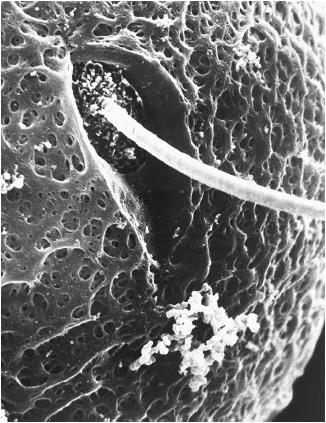Fertilization

Fertilization is the process by which the nucleus of a sperm (a male reproductive cell) fuses (combines) with the nucleus of an egg (a female reproductive cell; also called an ovum). Fertilization occurs somewhat differently in plants and animals. In flowering plants, two sperm cells are involved in the process of fertilization. The first sperm cell combines with an egg cell, while the second sperm cell combines with two nuclei present in the ovule (the structure that eventually becomes the seed). The structure formed in the second fertilization eventually forms a storage site for nutrients needed by the fertilized egg cell.
A fertilized egg cell is known as a zygote. Once formed, the zygote undergoes continuous cell division that eventually produces a new multicellular organism.

Fertilization in humans
In humans, fertilization occurs in the fallopian tubes of the female reproductive tract. It takes place within hours following sexual intercourse. Approximately 300 million sperm are released into a female's vagina during intercourse. However, only one of these sperm can actually fertilize the single female egg cell (also called an ovum). The successful sperm cell must enter the uterus and swim up the fallopian tube to meet the egg cell. There it passes through the thick coating surrounding the egg. This coating is known as the zona pellucida.
The head of the sperm cell contains enzymes (certain types of chemicals) that break through the zona pellucida and make it possible for the sperm to penetrate into the egg. Once the head of the sperm is inside the egg, the tail of the sperm falls off. The outside of the egg then thickens to prevent another sperm from entering.
In humans, a number of variables affect whether or not fertilization occurs following intercourse. One factor is a woman's ovulatory cycle. The ovulatory cycle is the series of events that bring about the ripening of an egg and its release from the ovaries. Human eggs can be fertilized for only a few days after ovulation, which usually occurs only once every 28 days.
Fertilization in other species
Nearly all forms of terrestrial (land) animals use some form of internal fertilization similar to that in humans. External fertilization, however, is more common among aquatic animals. It is simple enough for aquatic animals simply to dump their sperm and eggs into the water and let currents mix the two kinds of cells with each other.
Reproduction of the sea urchin is a typical example of external fertilization among aquatic animals. A male sea urchin releases several billion sperm into the water. These sperm then swim towards eggs released in the same area. Fertilization occurs within seconds when sperm come into contact and fuse with eggs.
External fertilization in animals
Although it does not occur naturally in animals very often, external fertilization is also a possibility. In the case of humans, for example, some form of external fertilization may be necessary when a male and female wish to have a child but one or the other is biologically incapable of contributing to the normal process of internal fertilization.
An example is the process known as in vitro fertilization. The expression in vitro means "in glass," that is, in a glass test tube or petri dish. The term is used in contrast to in vivo fertilization, where in vivo means "in a living organism."
During in vitro fertilization, eggs are removed surgically from a female's reproductive tract. Those eggs then can be fertilized by sperm that has been taken from a male and then stored in a test tube or petri dish. After the fertilized eggs have divided twice, they are reintroduced into the female's body. If all goes well, the embryo and fetus develop, eventually resulting in a normal birth.
In vitro fertilization has been performed successfully on a variety of domestic animals since the 1950s. In 1978, the first human birth following in vitro fertilization occurred in England. Since that time, the procedure has become a routine treatment for infertile couples who wish to have children.
[ See also Reproduction ; Reproductive system ]